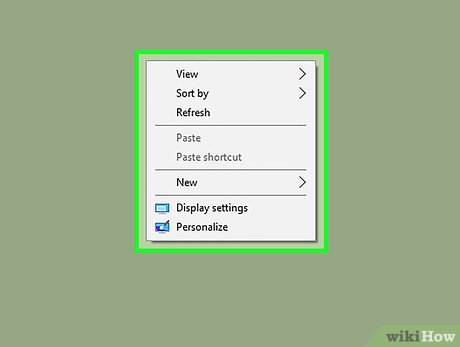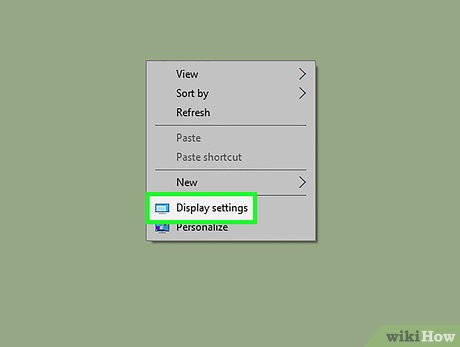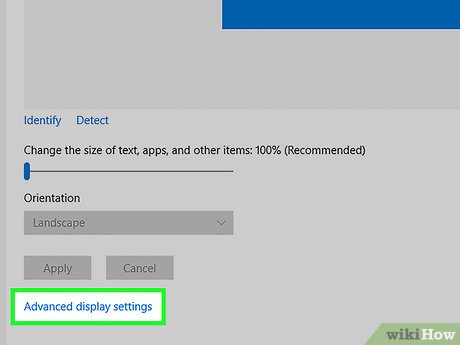How to Change the Screen Resolution on a PC
Method 1 of 5:
Windows 10
-
 Right-click the desktop. This will prompt a drop-down menu.
Right-click the desktop. This will prompt a drop-down menu. -
 Click Display settings. It's toward the bottom of the menu.
Click Display settings. It's toward the bottom of the menu. -
 Scroll down and click Advanced display settings. This link is at the bottom of the page.
Scroll down and click Advanced display settings. This link is at the bottom of the page. -
 Click the bar beneath the "Resolution" heading. Doing so will invoke a drop-down menu with different resolution values (e.g., "800 x 600").
Click the bar beneath the "Resolution" heading. Doing so will invoke a drop-down menu with different resolution values (e.g., "800 x 600"). -
 Click a resolution value. The resolution best-suited to your computer's screen will say "(Recommended)" next to it.
Click a resolution value. The resolution best-suited to your computer's screen will say "(Recommended)" next to it.- The higher the resolution number is, the smaller your computer's text and icons will appear.
-
 Click Apply. It's below the "Resolution" bar. Clicking this button will apply your selected resolution to the screen.
Click Apply. It's below the "Resolution" bar. Clicking this button will apply your selected resolution to the screen. -
 Click Keep changes. If you don't like your new resolution settings, you can click Revert or simply wait for a few seconds until the resolution automatically reverts to your computer's default setting.
Click Keep changes. If you don't like your new resolution settings, you can click Revert or simply wait for a few seconds until the resolution automatically reverts to your computer's default setting.
Method 2 of 5:
Windows 7 and 8
-
 Right-click the desktop. This will prompt a drop-down menu.
Right-click the desktop. This will prompt a drop-down menu. -
 Click Screen resolution. It's toward the bottom of the right-click menu.
Click Screen resolution. It's toward the bottom of the right-click menu. -
 Click the resolution bar. It's below the "Resolution" heading. Doing so will prompt a drop-down menu with different resolution values, such as "1920 x 1080."
Click the resolution bar. It's below the "Resolution" heading. Doing so will prompt a drop-down menu with different resolution values, such as "1920 x 1080."- On Windows 7, you may have a vertical slider here that allows you to click and drag a button up or down to increase or decrease the resolution.
-
 Click a resolution value. The resolution best-suited to your computer's screen will say "(Recommended)" next to it.
Click a resolution value. The resolution best-suited to your computer's screen will say "(Recommended)" next to it.- The higher the resolution number is, the smaller your computer's text and icons will appear.
-
 Click OK. It's at the bottom of the window. Doing so will prompt you to confirm your choice.
Click OK. It's at the bottom of the window. Doing so will prompt you to confirm your choice. -
 Click Yes when prompted. Doing so will save your resolution settings.
Click Yes when prompted. Doing so will save your resolution settings.- If you don't like the new resolution settings, you can click Revert or simply wait a few seconds for your computer's resolution to revert to your computer's default.
Method 3 of 5:
Windows Vista
-
 Right-click the desktop. This will invoke a drop-down menu.
Right-click the desktop. This will invoke a drop-down menu. -
 Click Personalize. It's toward the bottom of the right-click menu.
Click Personalize. It's toward the bottom of the right-click menu.- On some versions of Vista, this option may say Properties instead.
-
 Click Display Settings. This link is at the bottom of the "Personalize" window.
Click Display Settings. This link is at the bottom of the "Personalize" window. -
 Click and drag the "Resolution" slider left or right. It's near the bottom of the "Display Settings" window. Dragging the slider to the left will decrease your screen resolution, while dragging it to the right will increase the resolution.
Click and drag the "Resolution" slider left or right. It's near the bottom of the "Display Settings" window. Dragging the slider to the left will decrease your screen resolution, while dragging it to the right will increase the resolution.- Raising your resolution will make things smaller, while lowering the resolution will make things larger. If you are having difficulty seeing things on your computer, try lowering your resolution. If you want the clearest picture possible, raise the resolution to the size recommended for your display.
-
 Click OK. It's at the bottom of the window. Doing so will prompt you to confirm your choice.
Click OK. It's at the bottom of the window. Doing so will prompt you to confirm your choice. -
 Click Yes when prompted. Doing so will save your resolution settings.
Click Yes when prompted. Doing so will save your resolution settings.
Method 4 of 5:
Windows XP
-
 Right-click anywhere on the desktop. This will invoke a drop-down menu.
Right-click anywhere on the desktop. This will invoke a drop-down menu. -
 Click Properties. It's at the bottom of the menu. This will open the "Display Properties" window.
Click Properties. It's at the bottom of the menu. This will open the "Display Properties" window.- If "Display Properties" doesn't open to the "Settings" tab, click it at the top of the window.
-
 Click and drag the "Resolution" slider left or right. It's near the bottom of the "Display Settings" window. Dragging the slider to the left will decrease your screen resolution, while dragging it to the right will increase the resolution.
Click and drag the "Resolution" slider left or right. It's near the bottom of the "Display Settings" window. Dragging the slider to the left will decrease your screen resolution, while dragging it to the right will increase the resolution.- Raising your resolution will make things smaller, while lowering the resolution will make things larger. If you are having difficulty seeing things on your computer, try lowering your resolution. If you want the clearest picture possible, raise the resolution to the size recommended for your display.
-
 Click Apply. It's at the bottom of the window. After doing so, your screen will change resolution, and a confirmation box will appear.
Click Apply. It's at the bottom of the window. After doing so, your screen will change resolution, and a confirmation box will appear. -
 Click Yes when prompted. Doing this will save your resolution settings.
Click Yes when prompted. Doing this will save your resolution settings.- If you don't like the new resolution settings, wait for a few seconds; the screen will revert to the old settings.
-
 Click OK to close the "Display Properties" window. Your new resolution will be saved.
Click OK to close the "Display Properties" window. Your new resolution will be saved.
Method 5 of 5:
Windows ME
-
 Using a mouse, right click on an empty part of the screen. There should be a pop-up menu that appears.
Using a mouse, right click on an empty part of the screen. There should be a pop-up menu that appears. -
 Scroll over to View. Select how big you want your icons to be.
Scroll over to View. Select how big you want your icons to be.
3.5 ★ | 2 Vote



























 How to Get an Animated Desktop Background
How to Get an Animated Desktop Background How to Check Your Screen Resolution
How to Check Your Screen Resolution How to Remove Tempered Glass
How to Remove Tempered Glass How to Rotate Your Computer Screen
How to Rotate Your Computer Screen How to Set Up Dual Monitors
How to Set Up Dual Monitors How to Use the Huawei Broadband Stick to Send and Receive Text Messages
How to Use the Huawei Broadband Stick to Send and Receive Text Messages